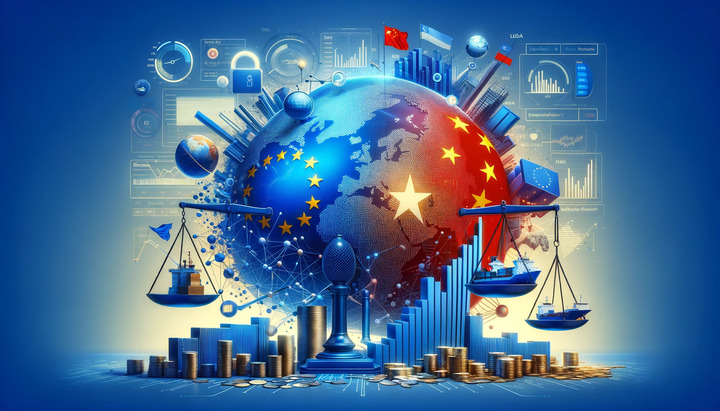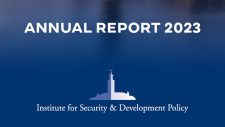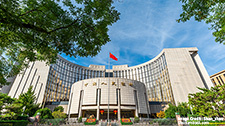Strategic Trade Dynamics: Unpacking De-risking and De-coupling in EU-China Relations

Brian Iselin
What goes on between the EU and China is of vital significance to global trade and our efforts to provide economic stability. Right now, the EU-China trade relationship could be characterised by its complex, involving cooperation, competition, and systemic rivalry (European External Action Service, 2024). The EU remains China’s largest trading partner, with bilateral trade in goods amounting to approximately €2.3 billion daily. However, this relationship is marked by a substantial and growing trade deficit, with the EU experiencing a deficit nearing €400 billion as of 2023 (Consilium, 2023).
Amid these developments, the concepts of de-risking and de-coupling have gained prominence in policy discussions and strategic considerations. You will not find any meeting about EU-China relations in which these two terms are not used. But they are very often mistakenly used synonymously. But de-risking refers to the process of identifying and mitigating risks in economic and trade engagements to protect national interests without severing economic ties. In contrast, de-coupling involves a more radical separation of economic activities, aimed at reducing dependence on a particular country or economic partner, often for strategic or security reasons (MERICS, 2024).
The significance of these concepts is underscored by recent geopolitical events and shifting global alliances. China’s stance of material and political support to Russia in its war in Ukraine has strained its relations with the EU, compelling European policymakers to reassess their economic and strategic dependencies on China. This reassessment has led to a heightened focus on de-risking strategies to safeguard Europe’s economic interests while maintaining essential trade relations (MERICS, 2024).
Furthermore, the United States’ role in European security and its approach towards China significantly influence the EU’s strategies. Any shift in US foreign policy could impact the EU’s stance on de-risking and de-coupling, emphasising the need for Europe to strengthen its economic resilience and strategic autonomy (MERICS, 2024).
The purpose of this article is to provide greater conceptual clarity on de-risking and de-coupling within the context of EU-China trade and supply chains. By delineating the principal characteristics of these concepts, this article aims to enhance understanding and facilitate more precise conversation on their application and implications. The analysis will explore the historical context, theoretical foundations, and practical examples of de-risking and de-coupling, offering insights into their respective roles in shaping future EU-China economic relations.
This investigation is crucial for the EU, balancing the need for economic engagement with China against the imperatives of national security and strategic autonomy. Understanding the nuances of de-risking and de-coupling will enable policymakers and businesses to develop informed strategies that address the risks and opportunities inherent in the EU-China trade relationship.
Conceptual Framework
1.1 Definition of Key Terms
De-risking and de-coupling are pivotal concepts in the discourse on international trade and economic strategy, particularly in the context of EU-China relations. De-risking involves strategies to minimise exposure to risks associated with economic engagements without entirely severing relationships. This process encompasses diversifying supply chains, enhancing regulatory frameworks, and building strategic reserves (Fritz, 2020). On the other hand, de-coupling signifies a more profound economic disengagement aimed at reducing dependency on a particular country. This often involves shifting production, investing in alternative markets, and implementing protectionist policies to safeguard national interests (Fritz, 2020).
1.2 Historical Context
The terms de-risking and de-coupling have evolved in response to significant geopolitical shifts and economic crises. Historically, these concepts gained traction during the Cold War era, where economic strategies were heavily influenced by geopolitical tensions. However, their relevance surged post-2008 financial crisis and more recently with the COVID-19 pandemic and the Russia-Ukraine conflict. The global disruptions caused by these events exposed vulnerabilities in supply chains and heightened the urgency for more resilient economic policies (Baldwin & Freeman, 2021).
1.3 Theoretical Underpinnings
The theoretical underpinnings of de-risking and de-coupling can be traced to economic and political theories that emphasise risk management and strategic autonomy. De-risking aligns with risk management theories which advocate for diversification and resilience in economic practices. These theories suggest that by spreading investments and supply sources, economies can better withstand shocks and uncertainties (Gereffi, 2020).
Conversely, de-coupling is rooted in strategic autonomy and national security theories. It underscores the need for countries to maintain control over critical industries and technologies, thereby reducing reliance on potentially adversarial nations. This approach is often driven by geopolitical considerations, where economic independence is seen as crucial for national security (Schneider-Petsinger, 2020).
1.4 Comparative Analysis of Both Concepts
While both de-risking and de-coupling aim to mitigate risks, they differ fundamentally in approach and implications. De-risking is generally seen as a pragmatic and flexible strategy, allowing for continued engagement while managing vulnerabilities. It often involves incremental adjustments and diversification without drastically altering existing economic relationships. De-coupling, however, is more radical and can lead to significant economic shifts. It involves deliberate and often large-scale efforts to reduce dependencies, which can result in economic disruptions and require substantial investments in alternative capabilities (Lew at al, 2021).
Understanding these distinctions is crucial for policymakers and businesses as they navigate the complexities of global trade. Misinterpreting or conflating these concepts can lead to suboptimal strategies that either fail to mitigate risks adequately or unnecessarily disrupt economic activities.
Principal Characteristics of De-risking
2.1 Risk Management in Supply Chains
De-risking in the context of supply chains involves identifying potential vulnerabilities and implementing strategies to mitigate these risks. This concept has gained traction as global supply chains have become increasingly complex and interdependent. The COVID-19 pandemic and geopolitical tensions, such as the US-China trade war, have highlighted the fragility of global supply chains, prompting businesses and governments to reconsider their risk management strategies (Gereffi, 2020).
Effective de-risking involves several key practices:
- Diversification of Suppliers: By diversifying their supplier base, companies can reduce their dependency on a single source or region. This strategy helps mitigate the impact of disruptions in specific areas and ensures a more resilient supply chain (Heinrich et al, 2022).
- Strengthening Domestic Industries: Governments can play a crucial role in de-risking by supporting domestic industries, particularly in critical sectors such as technology, pharmaceuticals, and energy. This support can take the form of subsidies, tax incentives, and investments in research and development (Shih, 2020).
- Enhanced Trade Agreements and Partnerships: Establishing new trade agreements and strengthening existing ones can help create alternative trade routes and reduce dependency on a particular country. For instance, the EU has sought to enhance trade relationships with countries in the Asia-Pacific region to balance its economic ties with China (European Commission, 2021).
2.2 Tools and Mechanisms
Several tools and mechanisms are used in de-risking strategies to ensure the robustness and continuity of supply chains:
- Supply Chain Mapping and Monitoring: By mapping out their supply chains and continuously monitoring them, companies can identify potential bottlenecks and vulnerabilities. This proactive approach enables timely interventions and adjustments to mitigate risks (Ivanov & Dolgui, 2020).
- Inventory Management and Strategic Reserves: Maintaining strategic reserves of critical materials and components can buffer against supply chain disruptions. Effective inventory management ensures that companies have the necessary resources to continue operations during crises (Chopra & Sodhi, 2014).
- Technology and Innovation: Leveraging advanced technologies such as artificial intelligence, blockchain, and the Internet of Things (IoT) can enhance the visibility and traceability of supply chains. These technologies enable real-time monitoring and predictive analytics, allowing for more informed decision-making (Tjahjono et al., 2017).
2.3 Case Studies
Several case studies illustrate the successful implementation of de-risking strategies:
- Toyota’s Lean Manufacturing and Just-in-Time (JIT) Production: Toyota’s approach to lean manufacturing and JIT production emphasises efficiency and waste reduction while maintaining flexibility and resilience. This model allows Toyota to respond quickly to disruptions and maintain continuity in its supply chain (Holweg, 2007).
- Apple’s Supplier Diversification: In response to the US-China trade tensions, Apple has diversified its supplier base by shifting production to countries such as Vietnam and India. This strategy reduces Apple’s dependency on Chinese manufacturers and mitigates the risks associated with geopolitical uncertainties (Feiner, 2020.
- European Union’s Strategic Resilience: The EU has taken significant steps to enhance its strategic resilience, particularly in the areas of digital and green technologies. Initiatives such as the European Battery Alliance and the EU’s focus on digital sovereignty aim to reduce dependencies on external suppliers and strengthen the region’s industrial base (European Commission, 2021).
These examples demonstrate the effectiveness of de-risking strategies in enhancing supply chain resilience and ensuring economic stability.
Principal Characteristics of De-coupling
3.1 Strategic and Political Motivations
De-coupling in the context of EU-China trade relations is primarily driven by strategic and political motivations. The concept stems from a desire to reduce economic dependence on a potentially adversarial nation, ensuring greater national security and technological sovereignty. The EU’s strategic motivations for de-coupling are influenced by several factors:
- National Security Concerns: The EU’s increasing apprehension about China’s influence on critical infrastructure, such as telecommunications and energy, has fuelled calls for de-coupling. The potential for foreign control over essential sectors poses significant security risks, prompting the EU to seek greater autonomy (Agarwala, 2021). The weaponisation of trade by China drives these concerns well beyond what might be considered trade apprehensions into the realm of trade fear.
- Technological Sovereignty: Ensuring control over critical technologies, particularly in the digital and high-tech sectors, is a key driver of de-coupling. The EU aims to reduce reliance on Chinese technology providers and foster its own innovation capabilities. This effort is exemplified by initiatives like the European Commission’s Digital Compass, which outlines goals for digital transformation and technological independence by 2030 (European Commission, 2021).
- Geopolitical Rivalry: The strategic competition between the US and China has significant implications for the EU. Aligning more closely with the US on certain policies, such as restrictions on Chinese technology firms, reflects a broader geopolitical strategy to counterbalance China’s rising influence.
3.2 Economic and Social Implications
De-coupling has far-reaching economic and social implications, affecting industries, labour markets, and consumer dynamics:
- Economic Shifts: De-coupling can lead to significant economic shifts, including the restructuring of global supply chains. Companies may relocate production facilities from China to other regions, impacting investment patterns and trade flows. This shift can create new opportunities for countries that become alternative production hubs (Lund et al., 2020).
- Impact on Industries: Specific industries, particularly those heavily reliant on Chinese manufacturing, such as electronics and automotive, may face disruptions and increased costs due to de-coupling. Companies in these sectors need to invest in new supply chain configurations and adapt to changing market dynamics (Baldwin & Freeman, 2021). Trade distorting measures like China’s EV subsidies leading to trade protective measures like anti-subsidy tariffs become both a feature and destabiliser of industry.
- Labour Market Effects: The relocation of production and the restructuring of supply chains can have profound effects on labour markets. While new job opportunities may arise in alternative production locations, job losses could occur in regions heavily dependent on trade with China. This necessitates policies to support workforce transitions and reskilling (Fritz, 2020).
- Consumer Impact: De-coupling can lead to changes in consumer prices and product availability. Increased production costs and shifts in supply chains may result in higher prices for goods, affecting consumer purchasing power and demand patterns (Frost, 2021).
3.3 Case Studies
Several case studies illustrate the implications and outcomes of de-coupling strategies:
- The US-China Trade War: The trade tensions between the US and China provide a prominent example of de-coupling in action. Tariffs and trade restrictions imposed by both countries have led to significant shifts in supply chains and investment flows. Many US companies have relocated production to countries such as Vietnam and Mexico to avoid tariffs and reduce dependency on China (Bown, 2021).
- The EU’s Approach to 5G and Huawei: The EU’s cautious stance on Chinese telecom giant Huawei underscores the strategic motivations for de-coupling. Several EU countries have imposed restrictions on Huawei’s malicious involvement in their 5G networks, citing security concerns. This move aligns with broader efforts to ensure technological sovereignty and protect critical infrastructure (European Commission, 2021).
- Japan’s Economic Security Strategy: Japan has also pursued de-coupling strategies to reduce dependency on Chinese supply chains. The Japanese government has incentivised companies to relocate production back to Japan or to diversify their supply sources. This strategy aims to enhance economic security and resilience in the face of geopolitical risks (Denyer, 2020).
- Lithuania’s Decoupling from China: Lithuania’s decision to enhance ties with Taiwan and reduce economic reliance on China exemplifies a strategic de-coupling approach. This move led to economic sanctions from China but also resulted in increased support from EU member states in solidarity and a reorientation of Lithuania’s trade relations, highlighting both the challenges and the geopolitical dimensions of de-coupling (Schultz, 2021; Iselin, 2024). Lithuania is a shining example of how solidarity can enable de-coupling and de-coupling can foster solidarity.
These case studies highlight the diverse applications and outcomes of de-coupling strategies, reflecting the complexities and trade-offs involved in reducing economic dependencies.
Comparative Analysis
4.1 De-risking vs. De-coupling
SO, de-risking and de-coupling, while related, are distinct strategies with unique objectives, methods, and outcomes.
- Objectives: De-risking is a more micro policy than de-coupling and aims to mitigate potential vulnerabilities and manage risks within existing economic relationships. It seeks to enhance resilience without entirely severing economic ties. In contrast, de-coupling is a more macro policy that de-risking, and focuses on reducing dependency on a particular country, often driven by strategic, political, or security considerations. This approach entails a more comprehensive separation of economic activities to ensure greater autonomy (Frost, 2021; Gereffi, 2020).
- Methods: De-risking typically involves diversification of suppliers, enhancing domestic production capabilities, and establishing robust regulatory frameworks. It emphasises flexibility and adaptability within the current economic structure (Chopra & Sodhi, 2014). De-coupling, on the other hand, may involve relocating production facilities, imposing trade restrictions, and developing independent technological capabilities. This approach often requires substantial investment and a significant restructuring of supply chains (Baldwin & Freeman, 2021).
- Outcomes: The outcomes of de-risking include improved supply chain resilience, reduced exposure to specific risks, and sustained economic engagement with minimal disruption. However, it may not fully address strategic vulnerabilities or geopolitical dependencies. De-coupling can lead to greater strategic autonomy and reduced geopolitical risks, but it often involves higher economic costs, potential trade disruptions, and short-term economic instability (Fritz, 2020; Lew, 2021).
4.2 Overlap and Misinterpretations
There are scenarios where de-risking and de-coupling are used interchangeably, leading to potential misinterpretations.
- Overlap: Both strategies aim to manage risks and enhance resilience. For example, diversifying supply chains can be seen as both a de-risking measure and a step towards de-coupling if it significantly reduces dependency on a particular country. Additionally, policies enhancing domestic production capabilities can serve dual purposes (Frost, 2021).
- Misinterpretations: Misunderstanding the distinctions can result in suboptimal policies. For instance, labelling all efforts to reduce dependency on Chinese technology as de-coupling may overlook the nuanced approaches of de-risking that aim to maintain engagement while managing specific risks. This can lead to overly aggressive strategies that might harm economic interests (World Economic Forum, 2023). If one means de-risking but speaks of de-coupling, damage can be done unnecessarily to trade relations.
4.3 Economic Models and Predictions
Economic models provide valuable insights into the potential impacts of de-risking and de-coupling on trade relations and economic stability.
- Impact Analysis: Models suggest that de-risking, by diversifying supply chains, can enhance overall economic stability without significant disruptions. This approach can help manage risks associated with geopolitical tensions and global crises (Gereffi, 2020). However, the costs associated with these adjustments need careful management to avoid adverse effects on competitiveness (Ivanov & Dolgui, 2020).
- Predictive Scenarios: Predictive models indicate that de-coupling, while potentially ensuring greater strategic autonomy, could lead to short-term economic instability and increased costs. Long-term benefits include reduced geopolitical risks and enhanced national security, but these come at the expense of higher initial investments and potential trade conflicts (Lund et al., 2020).
- Future Trade Relations: The future of EU-China trade relations needs to involve a blend of de-risking and de-coupling strategies. Policymakers will need to balance economic interests with strategic considerations, ensuring that resilience and autonomy do not come at the expense of economic growth and stability. Ensuring China cannot weaponise trade with the EU means de-coupling; de-risking does not go far enough. Coordinated efforts at the EU level will be crucial in managing these transitions effectively (European Commission, 2021).
Practical Implications for Policy and Business
5.1 Policy Recommendations
Effective policy frameworks are essential for managing the complexities of de-risking and de-coupling in EU-China trade relations. Policymakers should consider the following strategies:
- Clear Policy Definitions: Governments need to clearly define and differentiate between de-risking and de-coupling to guide strategic decisions and avoid confusion. This clarity will help align policies with specific economic and strategic goals (Evenett, 2020).
- Strengthening Domestic Capabilities: Investments in domestic industries, particularly in critical sectors like technology and healthcare, can reduce dependency on foreign suppliers. This includes funding for research and development, as well as incentives for domestic production (European Commission, 2021).
- Diversification of Trade Partners: Establishing and enhancing trade agreements with a broader range of countries can mitigate risks associated with over-reliance on a single partner. This strategy promotes economic resilience and opens new markets for businesses (Lund et al., 2020).
- Regulatory Frameworks: Developing robust regulatory frameworks that address national security concerns without stifling innovation and trade is crucial. This includes implementing measures to protect critical infrastructure and ensuring cybersecurity (McBride & Chatzky, 2019).
- Collaboration and Coordination: The EU should foster greater collaboration among member states and coordinate with international allies, such as the United States, to ensure a unified approach to managing economic dependencies and geopolitical risks (Wang, 2021). Responding to China’s “trade weapons” demands solidarity, as Lithuania demonstrated.
5.2 Business Strategies
Businesses also play a critical role in implementing de-risking and de-coupling strategies. Key strategies include:
- Supply Chain Resilience: Companies should map their supply chains to identify vulnerabilities and develop contingency plans. This may involve diversifying suppliers, increasing inventory levels, and investing in supply chain visibility technologies (Gereffi, 2020).
- Investing in Innovation: Businesses should invest in innovation and technology to enhance their competitiveness and reduce reliance on foreign technologies. This includes adopting Industry 4.0 technologies such as AI, IoT, and blockchain (Tjahjono et al., 2017).
- Strategic Partnerships: Forming strategic partnerships with suppliers and customers in diverse regions can help businesses navigate geopolitical risks and maintain stability in their operations (Heim, 2021).
- Risk Management Practices: Implementing comprehensive risk management practices, including scenario planning and stress testing, can prepare businesses for potential disruptions and ensure they can adapt quickly to changing circumstances (Chopra & Sodhi, 2014).
5.3 Future Trends and Considerations
As the global trade landscape continues to evolve, several future trends and considerations will shape the application of de-risking and de-coupling strategies:
- Technological Advancements: Ongoing advancements in technology will continue to influence supply chain dynamics and risk management practices. Companies and governments must stay abreast of these developments to leverage new tools and mitigate risks effectively (Ivanov & Dolgui, 2020).
- Geopolitical Shifts: Geopolitical shifts, including changing alliances and emerging trade blocs, will impact global trade patterns. Policymakers and businesses need to remain flexible and responsive to these changes to maintain economic stability and security (Lund et al., 2020). A stronger EU trade bloc, with greater self-reliance, will blunt China’s efforts to hurt the EU through trade measures.
- Sustainability and Resilience: There is an increasing emphasis on sustainability and resilience in supply chains. Future strategies will likely incorporate environmental considerations and social governance, aligning economic activities with broader sustainability goals (European Commission, 2021).
- Global Cooperation: Despite the focus on de-risking and de-coupling, global cooperation will remain essential in addressing shared challenges such as climate change, pandemics, and economic crises. Balancing national interests with international collaboration will be crucial for long-term stability (Wang, 2021).
Conclusions
The evolving dynamics of EU-China trade relations necessitate a clear understanding of de-risking and de-coupling to navigate the complexities of global economic interdependence and to effectively communicate to all parties what the endgame is. I hope in this article I have managed to outline well the conceptual distinctions, characteristics, and implications of these strategies, providing a framework for policymakers and businesses.
Key Findings:
- Conceptual Clarity: De-risking involves mitigating specific risks within existing economic frameworks, emphasising diversification and resilience. De-coupling entails a more profound strategic separation to ensure national security and technological sovereignty (Frost, 2021; Gereffi, 2020).
- Strategic Motivations: National security, technological sovereignty, and geopolitical rivalry drive the EU’s inclination towards de-coupling. In contrast, de-risking is often driven by economic considerations, aiming to manage vulnerabilities without severing ties (McBride & Chatzky, 2019; European Commission, 2021).
- Economic and Social Implications: Both strategies have significant economic and social ramifications. De-risking can enhance supply chain resilience with minimal disruption, while de-coupling can lead to short-term economic instability but greater long-term strategic autonomy (Baldwin & Freeman, 2021; Fritz, 2020).
- Policy and Business Strategies: Effective implementation requires clear policy definitions, investment in domestic capabilities, diversification of trade partners, and robust risk management practices. Businesses need to focus on supply chain resilience, innovation, and strategic partnerships (Chopra & Sodhi, 2014; Lund et al., 2020).
Future Directions:
- Technological Advancements: Continuous monitoring of technological trends and their implications for supply chain management will be crucial. Advanced technologies like AI and blockchain can provide new tools for risk mitigation and strategic planning (Ivanov & Dolgui, 2020).
- Geopolitical Shifts: Policymakers must remain adaptable to geopolitical changes, ensuring that economic strategies align with shifting global alliances and trade patterns. Building bloc solidarity is key for trade security.
- Sustainability and Resilience: Incorporating sustainability into supply chain and trade strategies will become increasingly important. The globalisation of both have left Europe unnecessarily and untenably vulnerable. A more holistic approach can enhance resilience while addressing broader environmental and social goals (European Commission, 2021).
Working through EU-China trade relations requires a balanced approach that integrates both de-risking and de-coupling strategies. We must be ready to protect ourselves in more than simply military means. Security in 2024 demands blended security, which blend must include trade. By understanding and applying these concepts effectively, the EU can enhance its economic resilience, ensure strategic autonomy, and maintain stable and productive international trade relationships.
Related Publications
-
The US and EU, and the Emerging Supply Chain Network: Politics, Prospects, and Allies
The Global Supply Chains have evolved from simply logistical achievements to being the bedrock of the global economy. Driven by technological advances and geopolitical shifts, this transformation underscores the critical […]
-
ISDP Annual Report 2023
ISDP’s Annual Report for the year 2023. We look back on 2023, a year in which tensions and conflicts captured the strategic space in ISDP’s focus areas, making headlines around […]
-
The Economic Leash: China’s Financial Tethers and Global Power Plays
China’s emphasis on Gross Domestic Product (GDP) growth and its integration into global markets have allowed it to wield significant influence internationally. Nonetheless, this focus on rapid expansion has created […]
-
Challenging Western Views: Understanding Power and Stability in East Asia; An Interview with DAVID C. KANG
Dr. David C. Kang is Maria Crutcher Professor of International Relations at the University of Southern California. A leading expert in East Asian security, international relations, and political economy, Dr. […]
-
BRICS: Evolving into a Vehicle for Inclusive Multilateralism?
Summary BRICS (Brazil, Russia, India, China, and South Africa) is a group of major emerging economies that seeks to reform global governance and foster alternatives to established financial institutions. First […]




